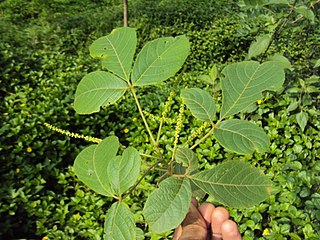Allophylus cobbe
| Titberry, Indian allophylus | |
|---|---|

| |
| Scientific classification | |
| Kingdom: | Plantae |
| Clade: | Tracheophytes |
| Clade: | Angiosperms |
| Clade: | Eudicots |
| Clade: | Rosids |
| Order: | Sapindales |
| Family: | Sapindaceae |
| Genus: | Allophylus |
| Species: | A. cobbe
|
| Binomial name | |
| Allophylus cobbe | |
| Synonyms[2] | |
|
List
| |
Allophylus cobbe, commonly known as titberry or Indian allophylus, is a pantropical, shrub in the family Sapindaceae with many uses in traditional medicine. It has a highly variable morphology throughout its range and may prove to be more than one species.
Description[edit]
The described size of Allophylus cobbe varies greatly from place to place. In Australia it is known as a small to large shrub, and "never a tree".[3] In India however it is described as a "shrub to small tree",[4] while in Papua New Guinea it is described as a tree "up to 25 m high".[5] The compound leaves are usually trifoliolate but may have from one to five leaflets.[5][6] The petiole may be from 2 to 11 cm (0.8 to 4.3 in) long, the petiolules of the leaflets up to 1 cm (0.39 in) long.[3][4][7] The leaflet blades are acuminate, obovate or elliptic, with pointed tips and cuneate bases, and the margins may be crenate towards the distal end.[3][4] The leaf surfaces vary from glabrous to tomentose[3][4]
Many small actinomorphic flowers to 2 mm (0.1 in) diameter are borne on a 2–16 cm (0.8–6.3 in) long inflorescence, which is racemose and may be branched or unbranched.[4][6] The resulting fruit are a glabrous red drupe measuring from 4 to 16 mm (0.2 to 0.6 in) in diameter, containing a single large seed.[3][4][5][7]
Taxonomy[edit]
This species was first described in Species Plantarum by Carl Linnaeus in 1753, who gave it the name Rhus cobbe.[8] It was later renamed Allophylus cobbe by William Forsyth Junior and published in Botanical Nomenclator in 1794.[9]
The wide variation in appearance of this species lead some to believe that it is polyphyletic and that the genus is in need of taxonomic revision.[3][6]
Distribution and habitat[edit]
Allophylus cobbe has a pantropical distribution, being found in tropical (and some subtropical) areas of Africa, Asia, Oceania and the Americas.[3][10]
It grows in monsoon forest, littoral forest and on the margins of mangrove forest, often on sandy soils. In Australia it is recorded at elevations from sea level to around 500 m (1,600 ft).[3][4][7][11]
Uses and ecology[edit]
Titberry has many uses in Ayurveda and other traditional medicine practices.[12] The plant has been used as a mouthwash and to treat ulcers and wounds, bone fractures, rashes, bruises, diarrhoea, fever and stomach ache.[3][4][13][14]
The timber has been used for roofing and firewood, and for making bows, rafts and fish traps. The fruits are edible, and can also be used as fish poison.[3][15][16]
This species is the host plant for the moths Cleora injectaria and Gonodontis clelia, and for the butterfly Nacaduba pavana singapura.[15][16]
Gallery[edit]
-
Fruits in QLD, Australia, April 2022
-
Flowers - QLD, Australia, April 2022
-
Leaves and flowers at Periya, India, 2014
-
Trifoliate leaves
References[edit]
- ^ "Species profile—Allophylus cobbe". Queensland Department of Environment and Science. Queensland Government. 2022. Retrieved 2 April 2022.
- ^ a b "Allophylus cobbe". Plants of the World Online. Royal Botanic Gardens, Kew. Retrieved 2 April 2022.
- ^ a b c d e f g h i j Reynolds, S.T. (2021). Busby, John R.; Kodela, P.G. (eds.). "Allophylus cobbe". Flora of Australia. Australian Biological Resources Study, Department of Agriculture, Water and the Environment: Canberra. Retrieved 2 April 2022.
- ^ a b c d e f g h Vattakaven Réjou-Méchain M, Muthusankar G, Ramesh B, Prabhakar, T; George, R; Balasubramanian, D; Réjou-Méchain, M; Muthusankar, G; Ramesh, B; Prabhakar, R (2016). "Allophylus cobbe". India Biodiversity Portal. Retrieved 4 April 2022.
{{cite web}}: CS1 maint: multiple names: authors list (link) - ^ a b c Conn, B.J.; Banka, R.; Lee, L.L. "PNG Trees". Plants of Papua New Guinea. Retrieved 4 April 2022.
- ^ a b c "Allophylus in Flora of China @ efloras.org". Flora of China. Missouri Botanical Garden, St. Louis, MO & Harvard University Herbaria, Cambridge, MA. Retrieved 3 April 2022.
- ^ a b c F.A.Zich; B.P.M.Hyland; T.Whiffen; R.A.Kerrigan (2020). "Allophylus cobbe". Australian Tropical Rainforest Plants Edition 8 (RFK8). Centre for Australian National Biodiversity Research (CANBR), Australian Government. Retrieved 2 April 2022.
- ^ "Rhus cobbe". International Plant Names Index (IPNI). Royal Botanic Gardens, Kew. 2021. Retrieved 4 April 2022.
- ^ "Allophylus cobbe". International Plant Names Index (IPNI). Royal Botanic Gardens, Kew. 2021. Retrieved 4 April 2022.
- ^ "Allophylus cobbe (L.) Forsyth fil". Global Biodiversity Information Facility. Retrieved 4 April 2022.
- ^ Cooper, Wendy; Cooper, William (2013). Australian Rainforest Fruits - A Field Guide. CSIRO Publishing. p. 477. ISBN 9780643107847.
- ^ "Allophylus cobbe". Medicinal Plant Names Services. Royal Botanic Gardens, Kew. Retrieved 5 April 2022.
- ^ Chavan, S.D.; Dias, R.J.; Magdum, C.S. (2019). "A Review on Medicinal Importance of Allophylus cobbe (L.) Raeusch and Garuga pinnata Roxburgh" (PDF). International Journal of Pharmacy and Biological Sciences. 9 (2): 1356–1362. ISSN 2230-7605. Retrieved 5 April 2022.
- ^ "Tit-berry". National Parks Board (NParks) of Singapore. Singapore Government. Retrieved 5 April 2022.
- ^ a b "Tit-berry (Allophylus cobbe)". Wild Singapore. Ria Tan. Retrieved 5 April 2022.
- ^ a b Beasley, John (2009). Plants of Cape York - the compact guide. John Beasley. p. 113. ISBN 978-0-9806863-0-2.




